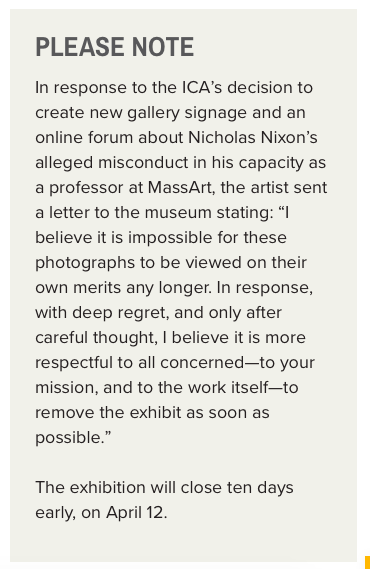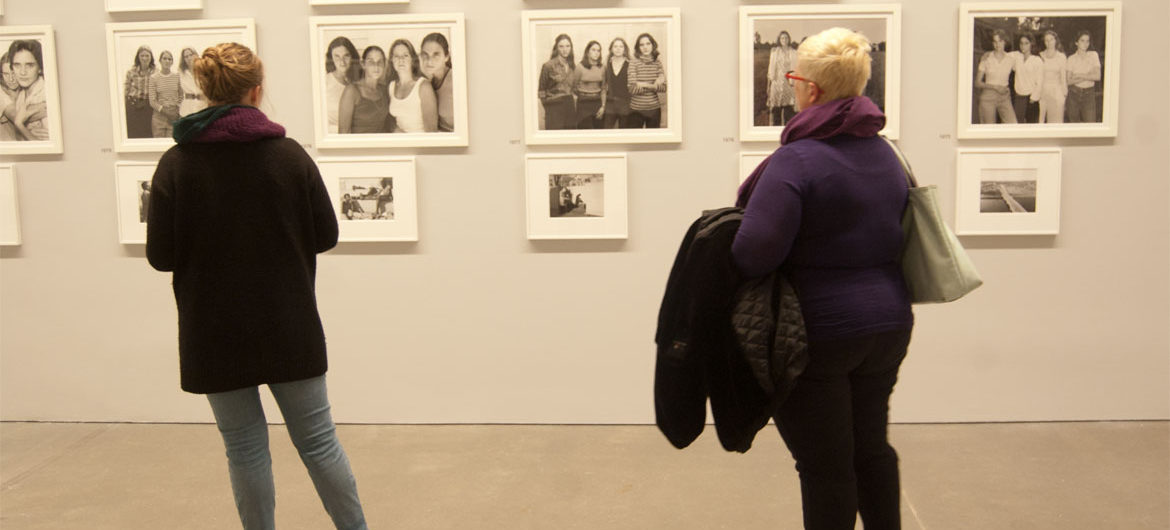The Institute of Contemporary Art will close its exhibition “Nicholas Nixon: Persistence of Vision” tomorrow—at the request of the famous Brookline artist, who has been facing allegations of “allegations of inappropriate behavior,” the Boston museum quietly announced with a note on its website today. And the online forum it launched less than a week ago to discuss the situation seems to have been deleted from the museum’s website.

The museum posted: “In response to the ICA’s decision to create new gallery signage and an online forum about Nicholas Nixon’s alleged misconduct in his capacity as a professor at MassArt, the artist sent a letter to the museum stating: ‘I believe it is impossible for these photographs to be viewed on their own merits any longer. In response, with deep regret, and only after careful thought, I believe it is more respectful to all concerned—to your mission, and to the work itself—to remove the exhibit as soon as possible.’ The exhibition will close ten days early, on April 12.”
On March 23, Wonderland was the first to report that Nixon had abruptly retired earlier that month from his longtime teaching position at Massachusetts College of Art and Design amid “allegations of inappropriate behavior,” according to a message sent out the day before by David Nelson, the Boston school’s president, to students, staff and alums.
On April 3, The Boston Globe published accounts from former students describing the allegations against Nixon in more detail: “For one assignment, the acclaimed professor asked students to photograph seven people they wanted to sleep with. For another, a female student was allegedly told to shoot 10 penises, while a male counterpart was asked to snap 10 vaginas. And why not start the assignment, the professor suggested, with each other?”
Last Friday, April 6, the ICA told Wonderland that it would continue the Nixon show. “Balancing diverging opinions within the ICA community as well as a commitment to thoughtful and due process, we will continue to keep this exhibition on view,” the museum said then. “And in the spirit of being a platform for diverse voices and perspectives, we are sharing the spectrum of opinion of many different ICA staff on this topic on our website and invite the public to participate in this online forum, which will go live shortly.”
The forum—which initially included comments from ICA Director Jill Medvedow and chief curator Eva Respini, who organized the Nixon exhibition—now seems to have disappeared. The URL where it had been hosted now produces an error message: “Sorry! Pardon us. This page isn’t currently available.” However, Wonderland has a copy of the forum texts.

What Was Said In The ICA’s Deleted Online Forum:
Below is a portion of the ICA’s online forum, including the introduction as well as comments by Medvedow, Respini and one additional anonymous ICA staff member. The forum included 18 posts attributed to anonymous ICA staff members, all but one of which were highly critical of ICA leaders’ decision to continue the Nixon exhibition.
OPEN FORUM
As misconduct and abuses of power are brought to light, how are cultural institutions to respond? Can museums separate art and an artist’s behavior? And should they? How does the behavior of an artist affect the way we present, read, and look at their work?
On April 4, the Boston Globe reported accounts of inappropriate behavior by artist Nicholas Nixon, whose work is scheduled to be on view at the ICA through April 22. This raises important questions about the relationship between art and an artist’s behavior, the responsibility incumbent on the museum in presenting an artist’s work, and the distinction between artistic freedom and academic codes of conduct. Balancing diverging opinions within the ICA community as well as a commitment to thoughtful and due process, we will keep the exhibition on view for its final weeks.
As we go forward, we are soliciting a spectrum of opinions among ICA staff, community, colleagues, and artists, and welcome your thoughts as well. We will continue to post responses from within our staff and invite you to participate below.
Jill Medvedow, Ellen Matilda Poss Director
POSTED APRIL 6
Since the allegations about inappropriate classroom behavior by photographer Nicholas Nixon, whose exhibition of photographs are on view at the ICA, were first announced by Massachusetts College of Art and Design and subsequently published in The Boston Globe, I have grappled with prioritizing the responsibilities of our museum and ensuring a thoughtful response, especially in our inflammatory times. I have thought long and hard about power and privilege, artistic and academic freedoms, responsibilities to our community of staff, members, artists, teens and visitors. I have reflected on our traditions of law and due process and I have thought about the messy relationships between imperfect human behavior, artistic conventions and transgressions, and changing rules and social codes of conduct.
So, I struggle with competing truths: the truth told by the individuals cited in The Globe, the divergent opinions of our staff, and the ICA’s commitment to share all that contemporary art offers to our many audiences and publics, including its controversies, complexities and conflicts. As we at the ICA work to advance justice, equity and openness in our museum and address our long history as an institution of white privilege, our programs seek to support and present artists who are changing and challenging long-held narratives, bringing voices of women, artists of color, and the LGBTQ community to our galleries, collection, stage and governance. Reading of Nick Nixon’s abuse of power is not only disturbing, it has forced difficult discussions about conviction and complicity in a system still so stacked against women and people of color.
Last night’s ICA Reads event reinforced the importance of dialogue and the need for public conversation. After considering diverging viewpoints from colleagues, artists, our very special ICA Teen Arts Council, and our leadership, we have decided to keep the exhibition – and the dialogue – open. I have invited the entire staff to contribute their perspectives to an open forum on this website and I invite each of you to contribute your thoughts.
Eva Respini, Barbara Lee Chief Curator
POSTED APRIL 6
I am deeply disturbed by the reports of Nicholas Nixon’s inappropriate behavior and sexual comments made to students while he was a professor at MassArt. Specifically, I am distressed by the nature of these allegations, which reflect a society where sexist and abusive behavior has gone unchecked for far too long, and powerful white men have eluded condemnation or prosecution for their actions. I curated Nixon’s exhibition currently on view at the ICA, and worked with him to realize the presentation. To date, the exhibition has been well received by our audiences and the press, and I think the reason many find the works to be compelling is because they speak to the nature of relationships, family, and – yes – the role of women. The exhibition centers around The Brown Sisters, his series of pictures of four strong, powerful women. Nixon portrays them with compassion and nuance, and as women on their own terms, not as objects to behold. I love these pictures because they are about how these women live their lives. It’s not about their bodies, their hair, or their clothes. It’s about them loving each other and supporting each other over decades. There is immense power in their sisterhood and unflinching gazes. And now it seems the maker of these pictures is a yet another man who has abused his position of power. I condemn this kind of behavior and am angered by it. Can I still love the pictures?
With these allegations, I am faced with some difficult questions. Does the work of an artist accused of questionable behavior need to be revisited or re-contextualized? Can we separate creative output from personal conduct? How do artists’ actions and views inform their work and shape our cultural narrative?
In my life and work I have sought to support and empower women and the voices of those traditionally underrepresented in museums by expanding the definition of what belongs in our institutions. I have organized major exhibitions of female artists, produced scholarship on their work, bought their art for museums to be preserved and shared for generations, and hired, mentored, and promoted women. I oversee a collection comprised of 63% art made by women – some of the work is explicitly feminist and addresses misogynistic representations of women and patriarchal inequity. I am honored to care for this collection and I often cite this statistic in public because women artists are still grossly underrepresented in museums.
Art’s long history is rife with artists of reprehensible moral character and criminal behavior. Works by artists with abhorrent beliefs and actions, past and present, are currently on view in museums all over the world. Museums must re-examine their own role and responsibility in the dialogues around power and inequity. The National Gallery of Art made news earlier this year when it decided to postpone exhibitions of Chuck Close and Thomas Roma after allegations of sexual misconduct and harassment came to light. The Pennsylvania Academy of Fine Arts decided to continue its exhibition of Close’s photography and mounted a counter exhibit exploring questions of gender and power and created a space for public dialogue.
As the Chief Curator at the ICA, I see my role as a champion for artists and also in service to my community. I see myself as a translator between artists and audiences. What is my role as I consider the allegations about an artist that I put on view in “my” museum? What is my responsibility and response, as woman and a feminist? As a champion of artists? As a public figure who serves audiences that include MassArt students, alumni, and faculty? If we see art through the lens of an artist’s conduct or beliefs, do we strip it of its intrinsic worth? These questions provoke the more fundamental issue: what is the role of museums in the world? What is a museum’s responsibility to shifting the dynamics of power, inequity, and building a more just society?
I have more questions than answers. What I do know, however, is that we must continue talking, questioning, and sharing our views, no matter how difficult it may be. I believe museums should be safe spaces for open dialogue and debate and I look forward to hearing from you online and in our galleries.
ICA Staff Member
POSTED APRIL 7
Once again, when presented with an opportunity to make a controversial but morally guided decision, the ICA chose to protect the problematic artist and its own pockets. By keeping this exhibition on view and by twisting this decision to be about public discourse, the ICA as an institution is silencing the voices of those who have come forward to name Nicholas Nixon as an abuser. This demonstrates the ICA has no intention of upholding the radical values it touts in its mission statement and most recent strategic plan.
Help Wonderland keep producing our great coverage of local arts, cultures and activisms by contributing to Wonderland on Patreon. And sign up for our free, weekly newsletter so that you don’t miss any of our reporting.
